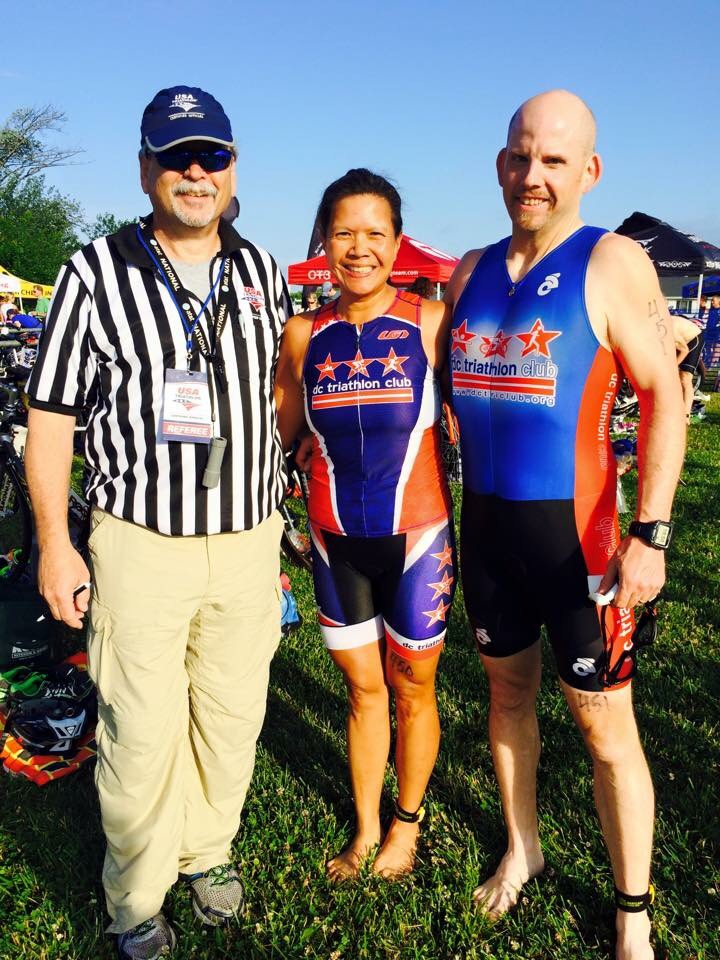
Meet the Referee
January, 2019Jim Littlefield, USAT Regional Officials Coordinator (ROC) for the Mid Atlantic Central Region. The MAC region includes Maryland, DC and Virginia.
How long have you been a member of DC Tri?
Since 2010.
How long have you been a USAT race official?
Since 2012. The first race I worked was the Columbia Triathlon in May 2012. Since then I’ve worked over 65 races including Eagleman four times, IM, Maryland three times along with numerous other IM 70.3 races.
What does a race official do?
On race day we’re on site at least ¼ hour before transition opens. The head referee will usually review how they want the officials to work the race. The head referee will take the “official” water temperature. Then we’ll be walking around transition. We’ll be checking for bar-end plugs, looking at helmets, sometimes checking for the CSPC sticker that should be inside the helmet, along with answering questions presented by the athletes. The head referee will observe the start of the race while the assistants prepare to go out on the bike course. On the bike course the officials will observe the athletes during the bike portion of the race. Depending on our reporting schedule, some of the officials will be on the run course observing that part of the race. Then it’s time to prepare our paperwork and discuss any potential rule violations with the head referee. The head referee is the only person that can access penalties in a USAT race. I point that out because at a WTC (Ironman) race the officials issue the penalties on the course and the athlete is supposed to stop and serve their penalty time in the penalty box.
What does a USAT Regional Officials Coordinator (ROC) do?
The ROC is responsible for reviewing the approved sanctions to determine the number of officials necessary for each specific race, then assigning the officials. After the race the ROC is responsible for collecting and reviewing the paperwork that the head referee submits after the race. The ROC is also responsible for investigating and possibly resolving any issues that may have come up relative that the specific race. The ROC also has paperwork to complete and submit to the USAT Commissioner of Officials. For the 2018 race season I had almost 50 races to assign, review and submit paperwork for.
What are your favorite, and least favorite, races?
I don’t have any favorite, or least favorite, races. I will say my least favorite conditions to work in are when it’s cool, or cold, windy and rainy. Cold and wet are the worst conditions, I bet a lot of athletes would agree with that. My favorite conditions to work in would be sunny, dry and around 70 degrees. Again, I’m sure a lot of athletes would agree with that.
Are there any funny things you’ve seen while officiating?
Something that all of us will see during the season would be athletes that have their helmet on backwards, which is probably not hard to do, especially for a novice. Over time I’ve seen a few athletes wearing aero helmets backwards. Remember, the rules require that your helmet is on and securely fastened; the rules don’t address how you wear your helmet.
Thanks for the opportunity to share what triathlon race officials do. I’ll end with two thoughts, take a few minutes and read the rules. There is usually a one page summary of the major rules in the athlete guide for just about every race. If you are assessed a penalty, take a moment and touch base with the head referee to learn what the violation was. Just like traffic court, if you question the penalty and there is a problem with it, the penalty can be thrown out
If anyone is interested in joining the USAT officials program please contact me at JimLittleUSAT@gmail.com.



